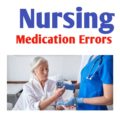What is a nursing diagnosis?
A nursing diagnosis is a clinical judgment concerning human response to health conditions/life processes, or vulnerability for that response, by an individual, family, group, or community. A nursing diagnosis provides the basis for the selection of nursing interventions to achieve outcomes for which the nurse has accountability. Nursing diagnoses are developed based on data obtained during the nursing assessment and enable the nurse to develop the care plan. Medical and nursing diagnoses have different goals: a medical diagnosis identifies a variation from a norm, while a nursing diagnosis should judge the existence of a potential for enhancing self-care.
Purposes of Nursing Diagnosis
The purpose of the nursing diagnosis is as follows:
- Helps identify nursing priorities and help direct nursing interventions based on identified priorities.
- Helps the formulation of expected outcomes for quality assurance requirements of third-party payers.
- Nursing diagnoses help identify how a client or group responds to actual or potential health and life processes and knowing their available resources of strengths that can be drawn upon to prevent or resolve problems.
- Provides a common language and forms a basis for communication and understanding between nursing professionals and the healthcare team.
- Provides a basis of evaluation to determine if nursing care was beneficial to the client and cost-effective.
- For nursing students, nursing diagnoses are an effective teaching tool to help sharpen their problem-solving and critical thinking skills.
Difference between Medical and Nursing Diagnoses
The term nursing diagnosis is associated with three different concepts. It may refer to the distinct second step in the nursing process, diagnosis. Also, nursing diagnosis applies to the label when nurses assign meaning to collected data appropriately labeled with NANDA-I-approved nursing diagnosis. For example, during the assessment, the nurse may recognize that the client is feeling anxious, fearful, and finds it difficult to sleep. It is those problems which are labeled with nursing diagnoses: respectively, Anxiety, Fear, and Disturbed Sleep Pattern. Lastly, a nursing diagnosis refers to one of many diagnoses in the classification system established and approved by NANDA. In this context, a nursing diagnosis is based upon the response of the patient to the medical condition. It is called a ‘nursing diagnosis’ because these are matters that hold a distinct and precise action that is associated with what nurses have autonomy to take action about with a specific disease or condition. This includes anything that is a physical, mental, and spiritual type of response. Hence, a nursing diagnosis is focused on care.
Comparison of Nursing and Medical Diagnoses
Nursing diagnoses vs medical diagnoses
A medical diagnosis, on the other hand, is made by the physician or advance health care practitioner that deals more with the disease, medical condition, or pathological state only a practitioner can treat. Moreover, through experience and know-how, the specific and precise clinical entity that might be the possible cause of the illness will then be undertaken by the doctor, therefore, providing the proper medication that would cure the illness. Examples of medical diagnoses are Diabetes Mellitus, Tuberculosis, Amputation, Hepatitis, and Chronic Kidney Disease. The medical diagnosis normally does not change. Nurses are required to follow the physician’s orders and carry out prescribed treatments and therapies.
As explained above, now it is easier to distinguish nursing diagnosis from that of a medical diagnosis. Nursing diagnosis is directed towards the patient and his physiological and psychological response. A medical diagnosis, on the other hand, is particular with the disease or medical condition. Its center is on the illness.
NANDA International (NANDA-I)
NANDA–International earlier known as the North American Nursing Diagnosis Association (NANDA) is the principal organization for defining, distribution and integration of standardized nursing diagnoses worldwide.
The term nursing diagnosis was first mentioned in the nursing literature in the 1950s. Two faculty members of Saint Louis University, Kristine Gebbie and Mary Ann Lavin, recognized the need to identify nurses’ role in an ambulatory care setting. In 1973, NANDA’s first national conference was held to formally identify, develop, and classify nursing diagnoses. Subsequent national conferences occurred in 1975, in 1980, and every two years thereafter. In recognition of the participation of nurses in the United States and Canada, in 1982 the group accepted the name North American Nursing Diagnosis Association (NANDA).
In 2002, NANDA became NANDA International (NANDA-I) in response to its significant growth in membership outside of North America. The acronym NANDA was retained in the name because of its recognition.
Review, refinement, and research of diagnostic labels continue as new and modified labels are discussed at each biennial conference. Nurses can submit diagnoses to the Diagnostic Review Committee for review. The NANDA-I board of directors give the final approval for incorporation of the diagnosis into the official list of labels. As of 2020, NANDA-I has approved 244 diagnoses for clinical use, testing, and refinement. READ: How To Become An Auxiliary Nurse In Nigeria
History and Evolution of Nursing Diagnosis
In this section, we’ll look at the events that led to the evolution of nursing diagnosis today:
The need for nursing to earn its professional status, the increasing use of computers in hospitals for accreditation documentation, and the demand for a standardized language from nurses lead to the development of nursing diagnosis.
Post-World War II America saw an increase in the number of nurses returning from military service. These nurses were highly skilled in treating medical diagnoses with physicians. Returning to peacetime practice, nurses were faced with renewed domination by physicians and social pressures to return to traditionally defined female roles with reduced status to make room in the workforce for returning male soldiers. With that, nurses felt increased pressure to redefine their unique status and value.
Nursing diagnosis was seen as the approach that could provide the “frame of reference from which nurses could determine what to do and what to expect” in a clinical practice situation.
Nursing diagnoses were also intended to define nursing’s unique boundaries with respect to medical diagnoses. For NANDA, the standardization of nursing language through nursing diagnosis was the first step towards having insurance companies pay nurses directly for their care.
In 1953, Virginia Fry and R. Louise McManus introduced the discipline-specific term “nursing diagnosis” to describe a step necessary in developing a nursing care plan.
In 1972, the New York State Nurse Practice Act identified diagnosing as part of the legal domain of professional nursing. The Act was the first legislative recognition of nursing’s independent role and diagnostic function.
In 1973, the development of nursing diagnosis formally began when two faculty members of the Saint Louis University, Kristine Gebbie and Mary Ann Lavin, perceived a need to identify nurses’ roles in ambulatory care settings. In the same year, the first national conference to identify nursing diagnoses was sponsored by the Saint Louis University School of Nursing and Allied Health Profession in 1973.
Also in 1973, the American Nurses Association’s Standards of Practice included diagnosing as a function of professional nursing. Diagnosing was subsequently incorporated into the component of the nursing process. The nursing process was used to standardize and define the concept of nursing care, hoping that it would help to earn professional status.
In 1980, the American Nurses Association (ANA) Social Policy Statement defined nursing as: “the diagnosis and treatment of human response to actual or potential health problems.”
International recognition of the conferences and the development of nursing diagnosis came with the First Canadian Conference in Toronto (1977) and the International Nursing Conference (1987) in Alberta, Canada.
In 1982, the conference group accepted the name “North American Nursing Diagnosis Association (NANDA)” to recognize the participation and contribution of nurses in the United States and Canada. In the same year, the newly formed NANDA used Sr. Callista Roy’s “nine patterns of unitary man” as an organizing principle since the first taxonomy listed nursing diagnosis alphabetically – which was deemed unscientific.
In 1984, NANDA renamed “patterns of unitary man” as “human response patterns” based on the work of Marjorie Gordon. Currently, the taxonomy is now called Taxonomy II.
In 1990 during the 9th conference of NANDA, the group approved an official definition of nursing diagnosis:
“Nursing diagnosis is a clinical judgment about individual, family, or community responses to actual or potential health problems/life processes. Nursing diagnosis provides the basis for selection of nursing interventions to achieve outcomes for which the nurse is accountable.”
In 1997, NANDA changed the name of its official journal from “Nursing Diagnosis” to “Nursing Diagnosis: The International Journal of Nursing Terminologies and Classifications.”
In 2002, NANDA changed its name to NANDA International (NANDA-I) to further reflect the worldwide interest in nursing diagnosis. In the same year, Taxonomy II was released based on the revised version of Gordon’s Functional health patterns. As of 2018, NANDA-I has approved 244 diagnoses for clinical use, testing, and refinement.
Classification of Nursing Diagnoses (Taxonomy II)
How are nursing diagnoses listed, arranged or classified? In 2002, Taxonomy II was adopted, which was based from the Functional Health Patterns assessment framework of Dr. Mary Joy Gordon. Taxonomy II has three levels: Domains (13), Classes (47), and nursing diagnoses. Nursing diagnoses are no longer grouped by Gordon’s patterns but coded according to seven axes: diagnostic concept, time, unit of care, age, health status, descriptor, and topology. In addition, diagnoses are now listed alphabetically by its concept, not by the first word.
Nursing Diagnosis Taxonomy II
Taxonomy II for nursing diagnosis contains 13 domains and 47 classes. Image via: Wikipedia.com
Domain 1. Health Promotion
Class 1. Health Awareness
Class 2. Health Management
Domain 2. Nutrition
Class 1. Ingestion
Class 2. Digestion
Class 3. Absorption
Class 4. Metabolism
Class 5. Hydration
Domain 3. Elimination and Exchange
Class 1. Urinary function
Class 2. Gastrointestinal function
Class 3. Integumentary function
Class 4. Respiratory function
Domain 4. Activity/Rest
Class 1. Sleep/Rest
Class 2. Activity/Exercise
Class 3. Energy balance
Class 4. Cardiovascular/Pulmonary responses
Class 5. Self-care
Domain 5. Perception/Cognition
Class 1. Attention
Class 2. Orientation
Class 3. Sensation/Perception
Class 4. Cognition
Class 5. Communication
Domain 6. Self-Perception
Class 1. Self-concept
Class 2. Self-esteem
Class 3. Body image
Domain 7. Role relationship
Class 1. Caregiving roles
Class 2. Family relationships
Class 3. Role performance
Domain 8. Sexuality
Class 1. Sexual identity
Class 2. Sexual function
Class 3. Reproduction
Domain 9. Coping/stress tolerance
Class 1. Post-trauma responses
Class 2. Coping responses
Class 3. Neurobehavioral stress
Domain 10. Life principles
Class 1. Values
Class 2. Beliefs
Class 3. Value/Belief/Action congruence
Domain 11. Safety/Protection
Class 1. Infection
Class 2. Physical injury
Class 3. Violence
Class 4. Environmental hazards
Class 5. Defensive processes
Class 6. Thermoregulation
Domain 12. Comfort
Class 1. Physical comfort
Class 2. Environmental comfort
Class 3. Social comfort
Domain 13. Growth/Development
Class 1. Growth
Class 2. Development
Nursing Process
The five stages of the nursing process are assessment, diagnosing, planning, implementation, and evaluation. In the diagnostic process, the nurse is required to have critical thinking. Apart from the understanding of nursing diagnoses and their definitions, the nurse promotes awareness of defining characteristics and behaviors of the diagnoses, related factors to the selected nursing diagnoses, and the interventions suited for treating the diagnoses.
The Nursing Process, also known as the “ADPIE”
Assessment
What data is collected? The first step of the nursing process is called assessment. When the nurse first encounters a patient, the former is expected to perform an assessment to identify the patient’s health problems as well as the physiological, psychological, and emotional state. The most common approach to gathering important information is through an interview. Physical examinations, referencing a patient’s health history, obtaining a patient’s family history, and general observation can also be used to collect assessment data.
Diagnosis
What is the problem? Once the assessment is completed, the second step of the nursing process is where the nurse will take all the gathered information into consideration and diagnose the patient’s condition and medical needs. Diagnosing involves a nurse making an educated judgment about a potential or actual health problem with a patient. More than one diagnoses are sometimes made for a single patient.
Planning
How to manage the problem? When the nurse, any supervising medical staff, and the patient agree on the diagnosis, the nurse will plan a course of treatment that takes into account short- and long-term goals. Each problem is committed to a clear, measurable goal for the expected beneficial outcome. The planning step of the nursing process is discussed in detail in Nursing Care Plans (NCP): Ultimate Guide and Database.
Implementation
Putting the plan into action. The implementation phase of the nursing process is when the nurse put the treatment plan into effect. This typically begins with the medical staff conducting any needed medical interventions. Interventions should be specific to each patient and focus on achievable outcomes. Actions associated in a nursing care plan include monitoring the patient for signs of change or improvement, directly caring for the patient or conducting important medical tasks, educating and guiding the patient about further health management, and referring or contacting the patient for a follow-up.
Evaluation
Did the plan work? Once all nursing intervention actions have taken place, the team now learns what works and what doesn’t by evaluating what was done beforehand. The possible patient outcomes are generally explained under three terms: the patient’s condition improved, the patient’s condition stabilized, and the patient’s condition worsened. Accordingly, evaluation is the last, but if goals were not sufficed, the nursing process begins again from the first step.
Types of Nursing Diagnoses
The four types of NANDA nursing diagnosis are Actual (Problem-Focused), Risk, Health promotion, and Syndrome. Here are the four categories of nursing diagnosis provided by the NANDA-I system.
Four Types of Nursing Diagnoses
The four types of nursing diagnosis are Actual (Problem-Focused), Risk, Health promotion, and Syndrome.
Problem-Focused Nursing Diagnosis
A problem-focused diagnosis (also known as actual diagnosis) is a client problem that is present at the time of the nursing assessment. These diagnoses are based on the presence of associated signs and symptoms. Actual nursing diagnoses should not be viewed as more important than risk diagnoses. There are many instances where a risk diagnosis can be the diagnosis with the highest priority for a patient.
Problem-focused nursing diagnoses have three components: (1) nursing diagnosis, (2) related factors, and (3) defining characteristics. Examples of actual nursing diagnosis are:
- Ineffective Breathing Pattern
- Anxiety
- Acute Pain
- Impaired Skin Integrity.
Risk Nursing Diagnosis
The second type of nursing diagnosis is called risk nursing diagnosis. These are clinical judgment that a problem does not exist, but the presence of risk factors indicates that a problem is likely to develop unless nurses intervene. The individual (or group) is more susceptible to develop the problem than others in the same or a similar situation because of risk factors. For example, an elderly client with diabetes and vertigo has difficulty walking refuses to ask for assistance during ambulation may be appropriately diagnosed with Risk for Injury.
Components of a risk nursing diagnosis include: (1) risk diagnostic label, and (2) risk factors. Examples of risk nursing diagnosis are:
- Risk for Falls
- Risk for Injury
Health Promotion Diagnosis
Health promotion diagnosis (also known as wellness diagnosis) is a clinical judgment about motivation and desire to increase well-being. Health promotion diagnosis is concerned in the individual, family, or community transition from a specific level of wellness to a higher level of wellness.
Components of a health promotion diagnosis generally include only the diagnostic label or a one-part-statement. Examples of health promotion diagnosis:
- Readiness for Enhanced Spiritual Well Being
- Readiness for Enhanced Family Coping
- Readiness for Enhanced Parenting
Syndrome Diagnosis
A syndrome diagnosis is a clinical judgment concerning with a cluster of problem or risk nursing diagnoses that are predicted to present because of a certain situation or event.
They, too, are written as a one-part statement requiring only the diagnostic label. Examples of a syndrome nursing diagnosis are:
- Chronic Pain Syndrome
- Post-trauma Syndrome
- Frail Elderly Syndrome
Possible Nursing Diagnosis
A possible nursing diagnosis is not a type of diagnosis as are actual, risk, health promotion, and syndrome. Possible nursing diagnoses are statements describing a suspected problem for which additional data are needed to confirm or rule out the suspected problem. It provides the nurse with the ability to communicate with other nurses that a diagnosis may be present but additional data collection is indicated to rule out or confirm the diagnosis. Examples include
- Possible Chronic Low Self-Esteem
- Possible Social Isolation.
Components of a Nursing Diagnosis
A nursing diagnosis has typically three components: (1) the problem and its definition, (2) the etiology, and (3) the defining characteristics.
Components of a Nursing Diagnosis Statement
A common format used when writing or formulating nursing diagnosis is the PES format.
Problem and Definition
The problem statement, or the diagnostic label, describes the client’s health problem or response for which nursing therapy is given as concisely as possible. A diagnostic label usually has two parts: qualifier and focus of the diagnosis. Qualifiers (also called modifiers) are words that have been added to some diagnostic labels to give additional meaning, limit or specify the diagnostic statement. Exempted in this rule are one-word nursing diagnoses (e.g., Anxiety, Fatigue, Nausea) where their qualifier and focus are inherent in the one term.
Etiology
The etiology, or related factors and risk factors, component of a nursing diagnosis label identifies one or more probable causes of the health problem, are the conditions involved in the development of the problem, gives direction to the required nursing therapy, and enables the nurse to individualize the client’s care. Nursing interventions should be aimed at etiological factors in order to remove the underlying cause of the nursing diagnosis. Etiology is linked with the problem statement with the phrase “as related to”.
Defining Characteristics
Defining characteristics are the clusters of signs and symptoms that indicate the presence of a particular diagnostic label. In actual nursing diagnoses, the defining characteristics are the identified signs and symptoms of the client. For risk nursing diagnosis, no signs and symptoms are present therefore the factors that cause the client to be more susceptible to the problem form the etiology of a risk nursing diagnosis. Defining characteristics are written “as evidenced by” or “as manifested by” in the diagnostic statement.
How to Write a Nursing Diagnosis?
In writing nursing diagnostic statements, describe the health status of an individual and the factors that have contributed to the status. You do not need to include all types of diagnostic indicators. Diagnostic statements can be one-part, two-part, or three-part statements. A common format used when writing or formulating nursing diagnosis is the PES format.
Writing Diagnostic Statements
Nursing diagnostic statements can be one-part, two-part, or three-part statements
One-Part Nursing Diagnosis Statement
Health promotion nursing diagnoses are usually written as one-part statements because related factors are always the same: motivated to achieve a higher level of wellness though related factors may be used to improve the of the chosen diagnosis. Syndrome diagnoses also have no related factors. Examples of one-part nursing diagnosis statement include:
- Readiness for Enhance Breastfeeding
- Readiness for Enhanced Coping
- Rape Trauma Syndrome
Two-Part Nursing Diagnosis Statement
Risk and possible nursing diagnoses have two-part statements: the first part is the diagnostic label and the second is the validation for a risk nursing diagnosis or the presence of risk factors. It’s not possible to have a third part for risk or possible diagnoses because signs and symptoms do not exist. Examples of two-part nursing diagnosis statement include:
- Risk for Infection related to compromised host defenses
- Risk for Injury related to abnormal blood profile
- Possible Social Isolation related to unknown etiology
- Three-part Nursing Diagnosis Statement
An actual or problem nursing diagnosis have three-part statements: diagnostic label, contributing factor (“related to”), and signs and symptoms (“as evidenced by”). Three-part nursing diagnosis statement is also called the PES format which includes the Problem, Etiology, and Signs and Symptoms. Examples of three-part nursing diagnosis statement include:
Impaired Physical Mobility related to decreased muscle control as evidenced by inability to control lower extremities.
Acute Pain related to tissue ischemia as evidenced by statement of “I feel severe pain on my chest!”
References and Sources
References for this Nursing Diagnosis guide and recommended resources to further your reading.
Ackley, B. J., & Ladwig, G. B. (2010). Nursing Diagnosis Handbook-E-Book: An Evidence-Based Guide to Planning Care. Elsevier Health Sciences. [Link]
Berman, A., Snyder, S., & Frandsen, G. (2016). Kozier & Erb’s Fundamentals of Nursing: Concepts, process and practice. Boston, MA: Pearson. [Link]
Edel, M. (1982). The nature of nursing diagnosis. In J. Carlson, C. Craft, & A. McGuire (Eds.), Nursing diagnosis (pp. 3-17). Philadelphia: Saunders.
Fry, V. (1953). The Creative approach to nursing. AJN, 53(3), 301-302.
Gordon, M. (1982). Nursing diagnosis: Process and application. New York: McGraw-Hill.
Gebbie, K., & Lavin, M. (1975.) Classification of nursing diagnoses: Proceedings of the First National Conference. St. Louis, MO: Mosby.
McManus, R. L. (1951). Assumption of functions in nursing. In Teachers College, Columbia University, Regional planning for nurses and nursing education. New York: Columbia University Press.
For the Complete List of NANDA-I Nursing Diagnosis: Herdman, H. T., & Kamitsuru, S. (Eds.). (2017). NANDA International Nursing Diagnoses: Definitions & Classification 2018-2020. Thieme. [Link]
NANDA. International. (2014). Nursing Diagnoses 2012-14: Definitions and Classification. Wiley.
Powers, P. (2002). A discourse analysis of nursing diagnosis. Qualitative health research, 12(7), 945-965. [Scribd]





